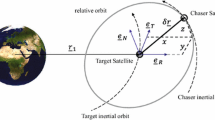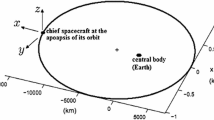Abstract
This paper deals with the stabilization of cluster flight on an elliptic reference orbit by the Hamiltonian structure-preserving control using the relative position measurement only. The linearized Melton’s relative equation is utilized to derive the controller and then the full nonlinear relative dynamics are employed to numerically evaluate the controller’s performance. In this paper, the hyperbolic and elliptic eigenvalues and their manifolds are treated without distinction notations. This new treatment not only contributes to solving the difficulty in feedback of the unfixed-dimensional manifolds, but also allows more opportunities to set the controlled frequencies of foundational motions or to optimize control gains. Any initial condition can be stabilized on a Kolmogorov–Arnold–Moser torus near a controlled elliptic equilibrium. The motions are stabilized around the natural relative trajectories rather than track a reference relative configuration. In addition, the bounded quasi-periodic trajectories generated by the controller have advantages in rapid reconfiguration and unpredictable evolution.




























Similar content being viewed by others
References
Alfriend, K.T., Vadali, S.R., et al.: Spacecraft Formation Flying. Elsevier, Amsterdam (2010)
Arnold, V.I.: Ordinary Differential Equations. Colonial Press, Miami (1973)
Badawya, A., McInnes, C.: Small spacecraft formation using potential functions. Acta Astronaut. 65(11–12), 1783–1788 (2009)
Breger, L., How, J.: Gauss’s variational equation-based dynamics and control for formation flying spacecraft. J. Guid. Control Dyn. 30(2), 437–448 (2007)
Broucke, R.A.: Solution of the elliptic rendezvous problem with the time as independent variable. J. Guid. Control Dyn. 26(4), 615–621 (2003)
Brown, O., Eremenko, P.: Fractionated space architectures: a vision for responsive space. In: 4th Responsive Space Conference, Los Angeles, AIAA-RS4-2006-1002 (2006)
Carter, T., Humi, M.: The Clohessy–Wiltshire equations can be modified to include quadratic drag. In: 13rd AAS/AIAA Space Flight Mechanics Meeting, Ponce, AAS 03-240 (2003)
Carter, T.E.: State transition matrices for terminal rendezvous studies: brief survey and new examples. J. Guid. Control Dyn. 21(1), 148–155 (1998)
Celletti, A., Chierchia, L.: KAM Stability and Celestial Mechanics. American Mathematical Society, Providence (2007)
Colombo, C., Xu, M., McInnes, C.: Stabilisation of the hyperbolic equilibrium of high area-to-mass spacecraft. In: 63rd International Astronautical Congress, Naples, Italy, IAC-12-C1.1.13 (Oct. 2–6 2012)
Gurfil, P.: Relative motion between elliptic orbits: generalized boundedness conditions and optimal formationkeeping. J. Guid. Control Dyn. 28(4), 761–767 (2005)
Gurfil, P., Kholshevnikov, K.V.: Manifolds and metrics in the relative spacecraft motion problem. J. Guid. Control Dyn. 29(4), 1004–1100 (2006)
Gurfil, P., Mishne, D.: Cyclic spacecraft formations: relative motion control using line-of-sight measurements only. J. Guid. Control Dyn. 30(1), 214–226 (2007)
Hu, Q., Zhang, J.: Relative position finite-time coordinated tracking control of spacecraft formation without velocity measurements. ISA Trans. 54, 60–74 (2015)
Lawden, D.: Fundamentals of space navigation. J. Br. Interplanet. Soc. 13(2), 87–101 (1954)
Liu, H., Li, J.F.: Terminal sliding mode control for spacecraft formation flying. IEEE Trans. Aerosp. Electr. Syst. 45(3), 835–846 (2009)
Liu, X., Kumar, K.D.: Network-based tracking control of spacecraft formation flying with communication delays. IEEE Trans. Aerosp. Electr. Syst. 48(3), 2302–2314 (2012)
McLoughlin, T.H., Campell, M.: Solutions to periodic sensor scheduling problems for formation flying missions in deep space. IEEE Trans. Aerosp. Electr. Syst. 47(2), 1351–1368 (2011)
Melton, R.G.: Time explicit representation of relative motion between elliptical orbits. J. Guid. Control Dyn. 23(4), 604–610 (2000)
Meyer, K.R., Hall, G.R., Offin, D.: Introduction to Hamiltonian Dynamical Systems and the N-Body Problem, 2nd edn. Springer, New York (2009)
Nazarenko, A.I.: State transition matrix of relative motion for the noncircular orbit: relation with partial-derivative matrix in the satellite coordinate system. In: International Astronatical Congress, Valencia, Spain, No. IAC-06-C1.6.08 (October 2006)
Sabatini, M., Izzo, D., Palmerini, G:. Analysis and control of convenient orbital configuration for formation flying missions. In: 16th AAS/AIAA Space Flight Mechanics Conference, Tampa, Florida, AAS 06-120 (2006)
Sabatini, M., Palmerini, G.: Linearized formation-flying dynamics in a perturbed orbital environment. In: 2008 IEEE Aerospace Conference, Bigsky, Montana, 1–8 March (2008)
Schaub, H., Junkins, J.L.: Analytical Mechanics of Space Systems. AIAA, New York (2003)
Schaub, H., Alfriend, K.T.: Hybrid cartesian and orbit element feedback law for formation flying spacecraft. J. Guid. Control Dyn. 25(2), 387–393 (2002)
Scheeres, D.J., Hsiao, F.Y., Vinh, N.X.: Stabilizing motion relative to an unstable orbit: applications to spacecraft formation flight. J. Guid. Control Dyn. 26(1), 62–73 (2003)
Sengupta, P., Vadali, S.S.: Analytical solution for power-limited optimal rendezvous near an elliptic orbit. J. Optim. Theory Appl. 138, 115–137 (2008)
Sengupta, P., Vadali, S.R., Alfriend, K.T.: Averaged relative motion and applications to formation flight near perturbed orbits. J. Guid. Control Dyn. 31(2), 258–272 (2008)
Soldini, S., Colombo, C., Walker, S.: Comparison of Hamiltonian structure-preserving and Floquét mode station-keeping for Libration-point orbits. In: AIAA/AAS Astrodynamics Specialist Conference, AIAA-2014-4118, San Diego, California, 4–7 Aug (2014)
Szebehely, V., Giacaglia, G.E.O.: On the elliptic restricted problem of three bodies. Astron. J. 69, 230–235 (1964)
Tschauner, J., Hempel, P.: Optimale Beschleunigeungsprogramme fur das Rendezvous-Manover. Astronaut. Acta 10, 296–307 (1964)
Vadali, S.R., Schaub, H., Alfriend, K.T.: Initial conditions and fuel-optimal control for formation flying satellite. In: AIAA GNC Conference, Portland, Oregon, Paper No. AIAA 99-426 (Aug 9–12 1999)
Vadali, S.R., Vaddi, S.S., Alfriend, K.T.: An intelligent control concept for formation flying satellites. Int. J. Robust Nonlinear Control 12, 97–115 (2002)
Vaddi, S.S., Vadali, S.R.: Linear and nonlinear control laws for formation flying. Adv. Astronaut. Sci. 114(1), 171–187 (2003)
Wang, P.K.C., Hadaegh, F.Y.: Formation flying of multiple spacecraft with autonomous rendezvous and docking capability. IET Control Theory Appl. 1(2), 494–504 (2007)
Xu, M., Xu, S.J.: Nonlinear dynamical analysis for displaced orbits above a planet. Celest. Mech. Dyn. Astron. 102(4), 327–353 (2008)
Xu, M., Xu, S.: Structure-preserving stabilization for Hamiltonian system and its applications in solar sail. J. Guid. Control Dyn. 32(3), 997–1004 (2009)
Xu, M., Xu, S.: Displaced orbits generated by solar sail for the hyperbolic and degenerated cases. Acta Mech. Sin. 28(1), 211–220 (2012)
Xu, M., Zhu, J., et al.: Application of Hamiltonian structure-preserving control to formation flying on a J2-perturbed mean circular orbit. Celest. Mech. Dyn. Astron. 113(4), 403–433 (2012)
Xu, M., Wei, Y., Liu, S.: Nonlinear dynamics of a two-chain, three-body formation system. J. Astronaut. Sci. 59(4), 609–628 (2012)
Yamanaka, K., Ankersen, F.: New state transition matrix for relative motion on an arbitrary elliptical orbit. J. Guid. Control Dyn. 25(1), 60–66 (2002)
Yakubovich, V.A., Starzhinskii, V.M.: Linear Differential Equations with Periodic Coefficients. Wiley, New York (1975)
Acknowledgments
The research is supported by the National Natural Science Foundation of China (11172020 and 11432001), and Beijing Natural Science Foundation (4153060).
Author information
Authors and Affiliations
Corresponding author
Rights and permissions
About this article
Cite this article
Xu, M., Liang, Y., Tan, T. et al. Cluster flight control for fractionated spacecraft on an elliptic orbit. Celest Mech Dyn Astr 125, 383–412 (2016). https://doi.org/10.1007/s10569-016-9685-0
Received:
Revised:
Accepted:
Published:
Issue Date:
DOI: https://doi.org/10.1007/s10569-016-9685-0




